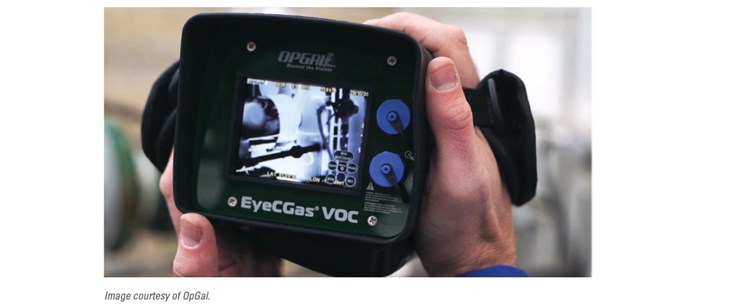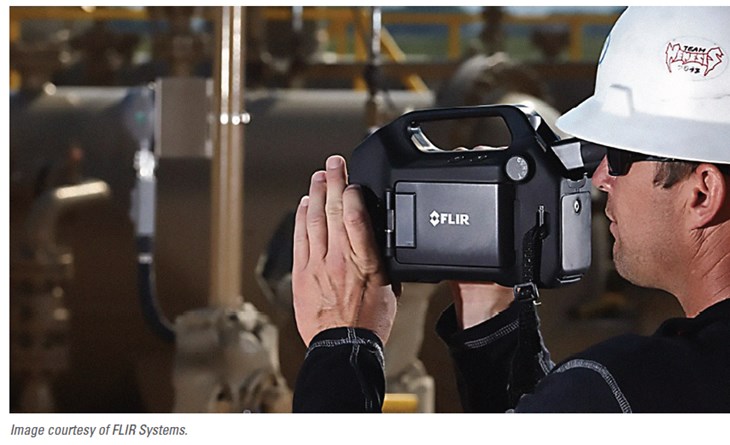Background
Many environmental professionals are aware of OGI technology and its application for Leak Detection and Repair (LDAR). Since it was published by EPA on December 2, 2008, however, the AWP it has not lived up to its expected billing as a truly transformative technology to replace conventional Method 21 monitoring for equipment leaks of volatile organic compounds (VOCs). Aside from the handful of facilities who have received approval for an alternate means of compliance (AMOC) to use OGI for annual monitoring of difficult-to-monitor components – those that require a technician to be elevated more than two meters above a support surface – OGI has been more beneficial to operations and maintenance departments than to environmental monitoring personnel. But the fate of OGI may soon change for petroleum refineries un-der a new protocol and amended AWP for optical gas imaging being drafted by EPA and expected to be issued in tandem later this year.
This new OGI protocol will ultimately reside in Appendix K of 40 CFR Part 60, Standards of Performance for New Stationary Sources (NSPS), alongside EPA test methods and other emission-related provisions. A comprehensively detailed draft Technical Support Document summarizing the historical technology development and numerous field and laboratory studies that led to the adoption and commercialization of OGI was published by EPA’s contractor, Eastern Research Group, in August 2015.
The upstream oil and gas industry, whose regulations under NSPS Subparts OOOO and OOOOa were promulgated following the AWP, incorporates optical gas imaging into fugitive emission rules without having to opt into the AWP, thereby avoiding the onerous (and costly) annual Method 21 monitoring requirement with a flame ionization detector. Despite technological advancements from camera makers featured in a recent Fugitive Emissions Journal article, the AWP and LDAR rules for the hydrocarbon processing industry have not changed to match the leak detection abilities currently available. Several years of experience with OGI surveys and the corresponding data have, however, helped build the case for a new AWP.

In anticipation of the new Appendix K protocol, lessons learned from applying OGI for LDAR in the U.S. midstream (natural gas processing plants) and Canadian downstream (refining) industry, which also has recent rules that incorporate OGI leak monitoring, can help explain the issues that will need to be over-come to establish a new alternate leak monitoring methodology to re-place an existing rule that requires physically monitoring every component. These issues were the topic of an October 28, 2020 webinar by the American Fuel & Petrochemical Manufacturers (AFPM) that was part of a series held in lieu of its annual environmental conference.
EPA convened an online OGI Stake-holders Workshop on November 9-10, 2020 to bring together leading companies to present the state of technology and collect input for the new protocol. The workshop covered several related topics – camera detection limits and quantification, performance variability, operator training and certification, and productivity based on case studies – to help inform the Agency and its staff tasked with proposing a framework. The enhanced abilities of the cam-era to detect leaks, which were established under the original AWP, are less critical to the protocol than the other aspects to ensure consistent implementation and results from OGI across different sites. Leak quantification with OGI through a separate peripheral device is likely not included as part of the protocol.
So there has been a lot of historical work to develop and adopt OGI as an alternative work practice and a lot of recent work to improve hydrocarbon resolution and to examine the methodology of monitoring to make it more uniform and therefore repeat-able for EPA to propose it as a full re-placement for Method 21. But being faster, safer, and more productive alone does not win hearts and minds at the Agency. EPA will need to agree that OGI alone will provide at least equivalent emissions reduction. OGI catches the “big” leakers (above 10,000 ppm) and its bimonthly frequency both results in shorter leak durations and identifies leaks from non-monitored refinery components like connectors and non-regulated equipment. Equivalent emissions reduction compared to the existing practice using Method 21 is challenging to demonstrate across for those “left behind” leaks that fall between above the lowest regulatory leak definition (2,000 ppm) and 10,000 ppm that OGI surveys do not reliably find. Case studies have shown that the annual Method 21 monitoring event included in the AWP renders it cost-neutral at best compared to conventional LDAR programs.
As to what the Appendix K Protocol may look like, OGI monitoring methodology is generally expect-ed to include uniform requirements for training, verification, surveying, recordkeeping, and reporting. Technician training, and potentially certification, has been suggested as a means to ensure that they are effectively conducting monitoring rather than just picking up a camera and being pointed in the direction of the unit. Industry data shows that qualified technicians with sufficient training and experience find more leaks.
Verification of camera imaging capability for instruments like these that do not require calibration consists of defining the criteria to confirm that the monitoring conditions such as wind speed, which can dilute and therefore conceal leaks, are within accepted limits for finding leaks on any day. All of these conditions – maximum distance, wind, delta temperature between a plume and its background – make a difference in enhancing or diminishing the camera’s effectiveness.

Though it may not be specifically addressed within the protocol, safety while surveying is a big advantage of using the camera that comes with its own set of safety considerations based on the physical limitations of the facility and the technician. OGI surveys are an inherently safer monitoring technique than Method 21 because the camera puts a technician further away from the hazard – be it hazardous hydrocarbons, high temperature of the equipment or steam lines, restricted spaces, etc. – and should not require as much body positioning as travers-ing the entire periphery of a component. Because the camera is heavier than a monitoring probe, some companies use ergonomic aids like a monopods or a shoulder harness to help avoid musculoskeletal injuries. Similarly, using the flip out screen for viewing instead of the eyepiece will re-duce eye fatigue, but using this must not compromise the technician’s ability to discern a plume on a dark screen in broad daylight. In addition, looking through eyepiece restricts one’s view, and it is easy to get tunnel vision that leads to injury even without damaging the expensive camera. Walking while surveying should be strictly avoided.
Even with the increased productivity, OGI technicians can still go too fast while surveying, creating the same EPA enforcement issues for failing to identify leaking equipment, resulting in the necessary repairs not being made and continuing fugitive VOC emissions. These issues led to enhanced LDAR provisions in refinery Consent Decrees 20 years ago that turned into more restrictive rules under NSPS Subparts VVa, GGGa, and OOOO. Current AWP guidelines are not well defined in terms of over-sight. Companies that have used both Method 21 and OGI for LDAR advise that training, auditing, and program evaluations still need to be implemented under either monitoring approach. What steps, there-fore, should be taken to place limits on the technician for monitoring? Global positioning systems originally used to keep tabs on technicians in the unit during Method 21 monitoring can also track progress along the required monitoring path as well as validate video location. At least one Texas facility has obtained a 3-second minimum survey time per component for all components with-in the camera frame to use OGI for LDAR. Keeping videos to audit leak detectability and survey pace (e.g., avoiding too much movement and too little stationary examination) and random OGI surveys for verification serve as recommended independent checks on technicians.
Finally, what level of recordkeeping and reporting is appropriate for inter-nal and regulatory oversight of OGI? Can you prove to a state inspector that you surveyed a specific piece of equipment? Video editing is fairly simple but it is still a time-consuming task to transfer recordings. A Petition for Reconsideration of the 2008 AWP claimed that maintaining the video record of each leak survey posed too much of a burden. Using GPS time-stamps in lieu of the continuous monitoring video requirement in the AWP has been proposed to EPA to resolve this concern. It is unclear whether EPA would require any additional re-porting elements beyond those specified in under the existing rules.
Conclusion
Like filmmaking, rulemaking is not as easy as it looks, and there are countless details to anticipate and administer to please your audience. Demonstrating equivalence with Method 21 by removing it from an amended AWP is a special effect worthy of a summer blockbuster, so it will be interesting to see what parts of the AWP end up on the editing room floor. But the red-carpet debut might have to wait longer than expected: under President Biden’s Executive Order 13990, EPA has a new priority of September 21 to re-view its actions over the prior four years, including the category of Reducing Methane Emissions in the Oil and Gas Sector. It looks like another sequel in the Subpart OOOOa series may hinder release of the OGI proto-col and amended AWP, but hopefully it will be worth the wait.


